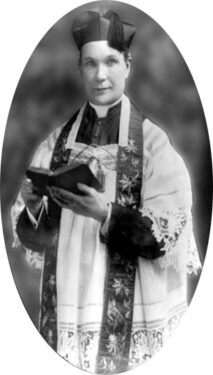
By Alexandra Moyen
ROSEDALE — On August 11, 1921, Father James Edwin Coyle was shot three times by Ku Klux Klan member Edwin Stephenson while sitting on the porch in front of his rectory at St. Paul’s Catholic Church in Birmingham, Alabama.
The reason? For being courageous enough to officiate the loving union between Stephenson’s daughter and a Puerto Rican man, at a time when that was considered taboo in Alabama.
This week marks the 99th anniversary of his martyrdom.
Born in County Roscommon, Ireland, on March 23, 1873, Father Coyle was ordained as a priest in 1896 in Rome at the age of 23. After his ordination, he became a pastor and a member of the Knights of Columbus in Mobile, Alabama. That was a moment when anti-semitism, anti-Catholicism, and racism were on the rise after a second wave of Klansmen emerged, inspired by the 1915 silent film, “Birth of a Nation,” which glorified the KKK and depicted black men as unintelligent and violent towards white women.
Alabama became one of many states that became intimidated by the wave of Catholics moving in. As a result, the state passed inspection laws, which gave the police the power to conduct unwarranted inspections of Catholic institutions. Father Coyle was known for encouraging parishioners to stand up for themselves and fight for their faith. The priest would respond to bigoted newspaper attacks with his letters and even wrote poetry on the subject. In an excerpt from his poem, “Our National Flag,” he wrote:
Oh, they lie, they lie and know it, the base and bigot crew
Who says such things do basely lie. They know that we are true.
They know full well, that all the years that saw Old Glory wave
Saw sons of Mother Church stand staunch, the bravest of the brave.
His teachings attracted a 12-year-old girl named Ruth, who one day wandered onto the front porch of his church while he was sitting outside. Her father, Edwin, a Methodist deacon, saw them together and punished her for talking to the priest. However, her fascination with the faith only grew, and at the age of 18, she converted to Catholicism on April 10, 1921. When her parents found out, she received a beating.
Ruth was eager to emancipate from her parents but couldn’t do so until she was 21, however under Alabama law, if she got married before then, she wouldn’t have to wait.
At the age of 13, she met Pedro Gussman, a Puerto Rican man who was boarding with her family. Gussman asked for her hand in marriage, but nothing came of it. After he left, they stayed in contact and Ruth eventually accepted his proposal a few years later, but knowing her parents wouldn’t approve, she asked Father Coyle for help with a ceremony. On August 11, he ministered their wedding. Two hours later, he was shot three times by Ruth’s father. He died less than an hour later at St. Vincent’s Hospital.
After shooting Father Coyle, Stephenson walked to the police station, confessed his crime, and was taken into custody. The trial that followed soon became national news, not only because many Alabamans sympathized with Stephenson but because with the help of a lawyer hired by the Klansmen, he pleaded not guilty because of insanity. The trial was a travesty of justice — the judge was a Klansmen — and the not guilty verdict came in only a few hours later.
Father Coyle was buried at Elmwood Cemetery, Birmingham, with his grave marked by a 10-foot-tall Celtic cross.
Today, he is remembered as a priest who chose love over hate.

Wow, powerful story, Alex. Thanks for sharing this!